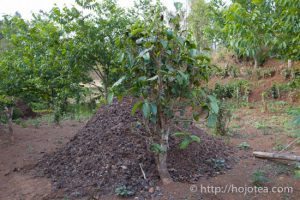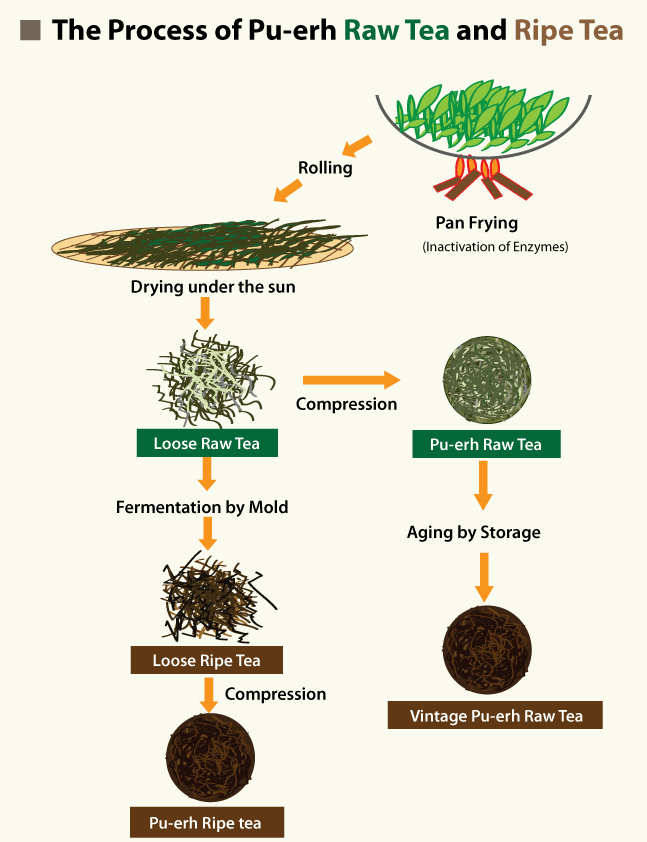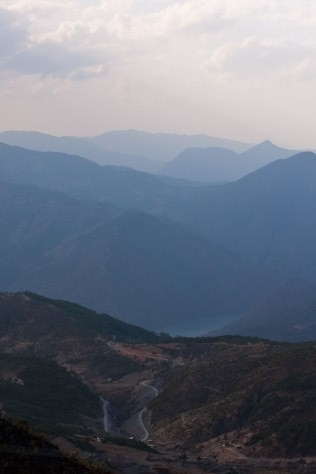Understanding the basics on how pu erh tea is made can help in discerning quality and tasting profiles for this complex tea. There are so many varieties of pu erh tea available now and many variations of quality and taste. Although some of the ancient tea trees in Yunnan that are the source of pu erh tea have been around for thousands of years, pu erh tea itself was originally introduced or “discovered” less than a thousand years ago – during the Ming dynasty. Cooked or ripe pu erh is a much more recent discovery that started in the late 1970s. Pu erh tea became very popular in the early 2000s and as a result prices skyrocketed as collectors especially in HK, Taiwan and Guangzhou caused a pu erh selling boom. During recent years the market has stabilized more and it seems the quality has also stabilized somewhat and from my experience it is easier nowadays to find decent quality pu erh tea without be afraid that someone is going sell you inferior fake quality tea – although it still happens!
Where is pu erh tea made?
Most pu erh tea originates from the following 4 main tea growing regions in the south of Yunnan province – which is located in Southern China, north of Thailand and close Laos, Vietnam and Myanmar.
The 4 main tea growing regions are
- Xishuang Banna
- Lin Cang
- Pu erh
- Chang Ning
Apparently the town of Pu erh was the logistics hub where the tea was stocked and prepared for trading, which is probably why the tea was named Pu erh.
How is Pu erh Tea Made – Green Pu erh tea and Cooked Pu erh tea
Pu erh tea is made in two different ways. One way is called Raw pu erh or Green (Sheng) pu erh. The other kind is Cooked pu erh or Ripe (Shou) pu erh. Both kinds are packaged in similar ways, but it is important to understand the difference.
The process of making raw pu erh is somewhat similar to the process of making regular green, although there are some differences. Firstly the picking of the tea leaf is similar to picking for oolong tea – usually 3-4 leaves and a bud are plucked. (green tea is usually 1-2 leaves and a bud – or sometimes just the buds). The leaves are pan fired – similar to Chinese green tea to halt the oxidization, but with pu erh tea the leaves are then allowed to naturally dry in the sun which does not completely stop the oxidization and causes some remaining enzymes to be active. It is this sunshine drying process that produces some of the typical flavors of raw pu-erh tea as some of the tea leaves are spontaneously fermented. Raw pu-erh tea is usually green when freshly made and will gradually turn yellow in a well managed storage environment. The taste is initially similar to a green tea. However with it being exposed a some oxidization while being stored it will develop some characteristics of white tea. As it gathers more oxidization over time it may take on similar characteristics of oolong tea and then eventually become more like a black tea.
The process of making cooked pu erh results in a similar fermentation process to aged raw pu erh but in a much shorter time period. Moisture and humidity are used to initiate the microbiological 1st stage of fermentation. Yeast and mold then dominates the 2nd stage of fermentation as the leaves dry out. These processes are critical to the final product quality and an improper fermentation process or drying process can affect the tea and give it an unpleasant earthy or moldy, musty flavor or smell. A good quality Cooked pu erh tea should produce a flavor some what similar to dried Chinese dates other types of dried fruit.
What Does Good Pu erh Tea Taste Like?
Learning to appreciate and understand a good tea – whether pu erh or any tea, is an ongoing process. Many of us simply go by our “gut feeling” of “I like it” or “I don’t like it”, which if fine, but like wine tasting there is science to tea tasting and understanding quality. The three main factors are 1.) Aftertaste; 2.) Body; 3.) Flavor. Others factors that can contribute to overall quality are freshness and processing defects.
Aftertaste:
This is the taste we feel in our throat – the taste that sort of lingers and lasts. In Chinese it is Hou Yun. Hou means throat and Yun literally means lasting lingering charm. The degree of aftertaste is determined by the amount of minerals contained in the tea leaf.
Body
The body refers to the overall fullness of the taste – the total mouth feel and the full concentration of the flavour in the mouth. When tea has a stronger body, we can enjoy a more intense flavour and richer mouth-feel. Calcium, potassium and other alkaline based minerals found naturally in the tea leaf affect the degree of body in the tea.
Flavor
Flavor does not so much determine the quality of tea, but more so defines its’ character. With pu erh teas the flavor can quickly help you determine issues such as improper fermentation and storage which will cause it to have unpleasant flavors such as moldy, earthy or “dried squid” flavors and aromas.
It is interesting to note that the qualities of Aftertaste and Body are defined by the quality of the original tea leaf and not by the processing. So this makes the source of the tea leaf the main criteria in setting the quality standard and not the factory or the tea “brand” . The main factors that affect the tea leaf quality and the richness of minerals are.
Altitude
A high altitude seems to be better for not only growing good tea but also for many kinds of fruits and vegetable. In a more highly elevated growing region, the tea trees can benefit from more extreme weather conditions – hotter sun during the day and colder temperatures at night. A a result the tea trees get richer substance into their leaves which is preserved and produces richer fuller bodied teas.
Soil Condition
The mineral composition in the soil affects the after taste and the body of tea. The advantage of using tea leaves from native tree grown on the mountain slopes is that there are a lot of dry leaves and debris on the ground. As time goes by this material gets decomposed and is eventually absorbed back into the ground. The native trees are able to naturally absorb these minerals easier and more quickly than regular garden tea.
Frequency of Harvest
The first picking will usually produce the best quality tea. If a tea tree is over picked too many times in one year, then the following years harvest will be lower quality due to the lower mineral content because the tree has to work harder. Whereas if the leaves are only picked once during spring, there will be plenty of time for the new leaves to accumulate minerals for the following harvest.
The age of tea tree
Old tea trees naturally have long, deep root systems with large surface areas and are able to absorb a lot of minerals from the soil. The age of the tea tree in Yunnan is important for tea makers in determining final tea leaf quality.
Agricultural Practices

This tea tree happens to grow right next to a pile of organic fertilizer. The leaves have grown unnaturally big. Picture courtesy of Hojo tea
Like in most parts of the world, in order to increase production “natural” fertilizers have been introduced to Yunnan. It is interesting to note that even so called “organic” fertilizers are not very natural in Yunnan and are in fact quite “unnatural”. The tea leaves grow bigger and greener and faster whenever an organic or non-organic fertilizer is used so long as it contains nitrogen. The wild tea trees and plants in the forest and on the slopes of the mountains that are not provided with any fertilizer still seem to have a sufficient supply of nitrogen. The secret is the soil.
Another practice that is becoming popular is to prune and cut the middle out of the tea tree, so that is produces more leaves at a faster rate. But the quality and mineral content of new leaves is not as good as a tree with slowly grown leaves,
Quality year
Similar to wine, the vintage or the year of harvest can affect the quality of the tea. this is important with pu erh tea because of the storage factor. It makes sense to stock up on tea that you know was produced in a good year.
As a general guide, warm, dry and sunny weather conditions are better for good quality tea as the tea trees can then absorb more sunshine for the photo synthesis process. The temperature at night also tends to be lower during dry weather conditions. Hotter weather and less rain usually results in the tea tree and leaf growth being slower. Often higher rainfall and fast growing spring seasons can result in tea taste getting a bit “thinner”.
Enjoying Pu erh Tea
Generally speaking a good pu erh tea should smell and taste good. If it carries a musty, moldy or dirty earthy profile, the quality is questionable. Although the aging of tea does not necessarily improve the after taste (as it is mineral based), aging does create a variety of rich flavors. Aging develops a warmer, mellower and sometimes richer tasting profile and can make the brew gentler and softer on the tongue. But is is basically a personal preference. Many people prefer a well fermented cooked pu erh – which can be enjoyed within a year and does not need to undergo the natural aging process.
As for me, a well stored and matured 10 – 20 year old raw pu erh is as good as it gets. What is your experience with pu erh tea?
For information on where to buy pu erh tea see HERE
For information on pu erh tea health benefits see HERE







Hi Peter, Very interesting and informative article here. I personally had no idea that there was such a thing as a matured tea! I love a nice cup of tea, but usually drink regular black tea with milk and sugar. This particular pu erh tea sounds similar to wine with importance placed on the age of the plant, also similar to coffee with regard to growth at higher altitude being beneficial.
Thanks for sharing, Kris
Hi Kris. Thanks for your note. Yes there is a whole world of interesting teas out there.